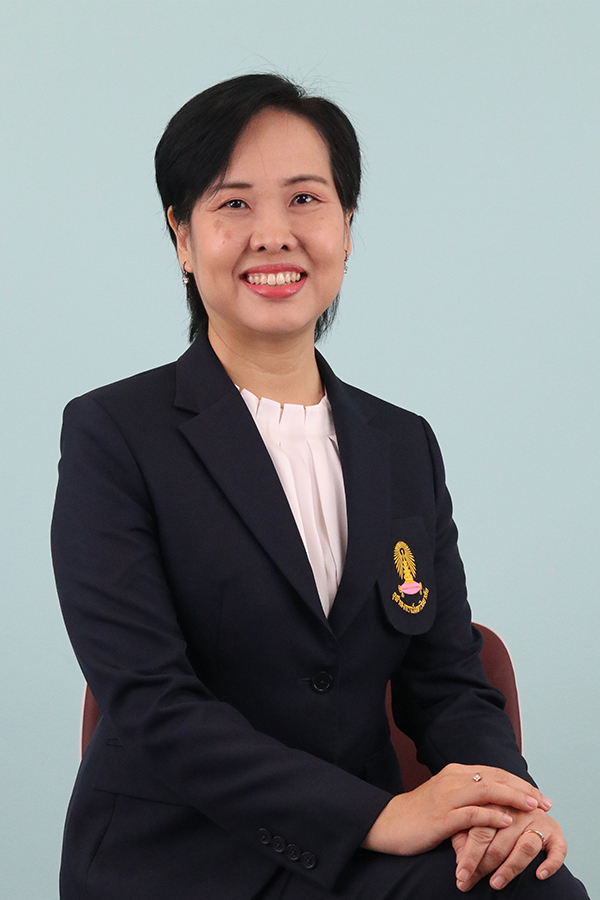
Associate Professor Nisachon Tangsangiumvisai, Ph.D.
รศ. ดร.นิศาชล ตั้งเสงี่ยมวิสัย
Education
- Ph.D. (Signal Processing), Imperial College, University of London, U.K. (1997-2001)
- MEng. (Electrical and Electronics Engineering), Imperial College London, U.K. (1993-1997)
- A Level, Brooke House 6th Form College, U.K. (1992-1993)
Email: Nisachon.T@chula.ac.th
Research Interest
- Adaptive Filtering and its applications :Acoustic Echo Cancellation in Hands-free Communications, Feedback Cancellation in Hearing-aid Devices, etc.– Digital Signal Processing (DSP) and its applications :Subband and multi-rate processing, etc.
- Noise Reduction Techniques for Speech Enhancement : Adaptive Noise Cancellation, Spectral Subtraction Method, Noise Reduction, etc.
Research Cluster
Bhattacharya, P C; Tangsangiumvisai, N; Worapishet, A
In: IEEE Access, vol. 8, pp. 168361-168380, 2020, ISSN: 21693536, (cited By 0).
@article{Bhattacharya2020,
title = {Performance improvement of adaptive wavelet thresholding for speech enhancement using generalized Gaussian priors and frame-wise context modeling},
author = {P C Bhattacharya and N Tangsangiumvisai and A Worapishet},
url = {https://www.scopus.com/inward/record.uri?eid=2-s2.0-85102733816&doi=10.1109%2fACCESS.2020.3023348&partnerID=40&md5=0a53c898860d134e25f66002975d78a5},
doi = {10.1109/ACCESS.2020.3023348},
issn = {21693536},
year = {2020},
date = {2020-01-01},
journal = {IEEE Access},
volume = {8},
pages = {168361-168380},
publisher = {Institute of Electrical and Electronics Engineers Inc.},
abstract = {This work aims at developing an adaptive wavelet thresholding algorithm for speech enhancement with significant performance improvement over other wavelet-based counterparts. This is accomplished through the formulation of the optimum threshold for noise reduction, based on the generalized Gaussian priors to fully characterize the statistics of speech and noise wavelet coefficients. In addition, through the frame-wise context modeling which enables tracking of the statistical characteristics of each individual coefficient on the frame-wise basis, the optimum threshold is accurate and adaptive at both the coefficient level and frame level. The frame-wise context model is formulated by virtue of the context subspace projection of the wavelet coefficients, with the context index employed as the invariant correspondence between successive frame parameters, thereby enabling the frame-wise tracking at the coefficient level. Simulation results show significant improvement over the wavelet-based speech enhancement algorithms in terms of the segmental signal-to-noise ratio improvement by as much as 226%, the perceptual evaluation of speech quality by 36%, the short-time objective intelligibility by 17.8% and the cepstral distance by 33.3%. When benchmarked with the well-established short-time-Fourier-transform-based counterparts, the proposed wavelet thresholding algorithm offers favorable and more robust performances, particularly under non-stationary noise conditions, with no adverse musical noise effect. This work is licensed under a Creative Commons Attribution 4.0 License. For more information, see https://creativecommons.org/licenses/by/4.0/},
note = {cited By 0},
keywords = {},
pubstate = {published},
tppubtype = {article}
}
Khemwong, J; Tangsangiumvisai, N
A two-step adaptive noise cancellation system for dental-drill noise reduction Journal Article
In: Engineering Journal, vol. 22, no. 4, pp. 51-66, 2018, ISSN: 01258281, (cited By 1).
@article{Khemwong2018,
title = {A two-step adaptive noise cancellation system for dental-drill noise reduction},
author = {J Khemwong and N Tangsangiumvisai},
url = {https://www.scopus.com/inward/record.uri?eid=2-s2.0-85051326383&doi=10.4186%2fej.2018.22.4.51&partnerID=40&md5=66784fa2b830830ed51b4077e5cabc2e},
doi = {10.4186/ej.2018.22.4.51},
issn = {01258281},
year = {2018},
date = {2018-01-01},
journal = {Engineering Journal},
volume = {22},
number = {4},
pages = {51-66},
publisher = {Chulalongkorn University},
abstract = {This paper introduces a two-step dental-drill Noise Reduction (NR) technique based upon the Adaptive Noise Cancellation (ANC) system. The proposed technique is particularly designed for the NR headphone, which the patients should be wearing while having their dental treatment. Similarly, the dentists are also suggested to wear these NR headphones to prevent hearing impairment due to excessively high level of drill noise. In the first step of the proposed NR technique, a tone-frequency extraction algorithm is proposed to estimate the main spectral component of the dental-drill noise. A sinusoidal signal with the estimated tone frequency is generated and subsequently fed to the first adaptive filter of the ANC system to remove the main tone frequency from the dental-drill noise. In the second-step, another adaptive filter of the ANC system is then employed to eliminate the residual high-frequency components of the dental-drill noise. Computer simulations based on recorded dental-drill sounds and real speech signals demonstrate the effectiveness of the proposed two-step dental-drill NR (TSDNR) technique, both in terms of the noise attenuation performance and the speech quality of the enhanced speech signal. Moreover, results of a subjective listening test with 15 listeners are also given to guarantee satisfied speech quality of the enhanced speech signal employing the proposed TSDNR technique. © 2018, Chulalongkorn University. All rights reserved.},
note = {cited By 1},
keywords = {},
pubstate = {published},
tppubtype = {article}
}
Aung, T T; Thumchirdchupong, H; Tangsangiumvisai, N; Nishihara, A
Two-microphone subband noise reduction scheme with a new noise subtraction parameter for speech quality enhancement Journal Article
In: IET Signal Processing, vol. 9, no. 2, pp. 130-142, 2015, ISSN: 17519675, (cited By 3).
@article{Aung2015,
title = {Two-microphone subband noise reduction scheme with a new noise subtraction parameter for speech quality enhancement},
author = {T T Aung and H Thumchirdchupong and N Tangsangiumvisai and A Nishihara},
url = {https://www.scopus.com/inward/record.uri?eid=2-s2.0-84928182081&doi=10.1049%2fiet-spr.2013.0182&partnerID=40&md5=0261486aae8bef59e5dd8c599b2a52f9},
doi = {10.1049/iet-spr.2013.0182},
issn = {17519675},
year = {2015},
date = {2015-01-01},
journal = {IET Signal Processing},
volume = {9},
number = {2},
pages = {130-142},
publisher = {Institution of Engineering and Technology},
abstract = {An improved subband noise reduction technique is proposed for two-microphone voice communication systems. The technique aims to enhance the speech quality by utilising a subband structure with different noise reduction schemes for different frequency bands. In the low-frequency band where dominant cues of speech spectral components are usually located and the noise signals from the two channels are mainly correlated, the spectral subtraction method, together with a new variable noise subtraction parameter, is employed so that the noise attenuation performance and speech distortion are controllable. In the high-frequency band where less-dominant frequency information of speech spectrum is located, the modified cross-spectral subtraction technique is utilised to remove the high-frequency decorrelated noise spectral components. Extensive comparisons among various noise reduction techniques based on computer simulations demonstrate that the proposed two-microphone subband noise reduction scheme achieves excellent noise attenuation performance while preserving the speech quality. © The Institution of Engineering and Technology 2015.},
note = {cited By 3},
keywords = {},
pubstate = {published},
tppubtype = {article}
}
Thoonsaengngam, R; Tangsangiumvisai, N
The a priori SDR estimation techniques with reduced speech distortion for Acoustic Echo and Noise Suppression Journal Article
In: IEICE Transactions on Communications, vol. E92-B, no. 10, pp. 3022-3033, 2009, ISSN: 09168516, (cited By 4).
@article{Thoonsaengngam2009,
title = {The a priori SDR estimation techniques with reduced speech distortion for Acoustic Echo and Noise Suppression},
author = {R Thoonsaengngam and N Tangsangiumvisai},
url = {https://www.scopus.com/inward/record.uri?eid=2-s2.0-77956571019&doi=10.1587%2ftranscom.E92.B.3022&partnerID=40&md5=6377658e692c36fd9858d6b69085d2c6},
doi = {10.1587/transcom.E92.B.3022},
issn = {09168516},
year = {2009},
date = {2009-01-01},
journal = {IEICE Transactions on Communications},
volume = {E92-B},
number = {10},
pages = {3022-3033},
publisher = {Institute of Electronics, Information and Communication, Engineers, IEICE},
abstract = {This paper proposes an enhanced method for estimating the a priori Signal-to-Disturbance Ratio (SDR) to be employed in the Acoustic Echo and Noise Suppression (AENS) system for full-duplex hands-free communications. The proposed a priori SDR estimation technique is modified based upon the Two-Step Noise Reduction (TSNR) algorithm to suppress the background noise while preserving speech spectral components. In addition, a practical approach to determine accurately the Echo Spectrum Variance (ESV) is presented based upon the linear relationship assumption between the power spectrum of far-end speech and acoustic echo signals. The ESV estimation technique is then employed to alleviate the acoustic echo problem. The performance of the AENS system that employs these two proposed estimation techniques is evaluated through the Echo Attenuation (EA), Noise Attenuation (NA), and two speech distortion measures. Simulation results based upon real speech signals guarantee that our improved AENS system is able to mitigate efficiently the problem of acoustic echo and background noise, while preserving the speech quality and speech intelligibility. Copyright © 2009 The Institute of Electronics, Information and Communication Engineers.},
note = {cited By 4},
keywords = {},
pubstate = {published},
tppubtype = {article}
}

